14.队列的顺序存储
1.队列的概念
1.1队列的定义
队列(queue)是只允许在一端进行插入操作,而在另一端进行删除操作的线性表。
队列是一种先进先出(First In First Out)的线性表,简称FIFO。允许插入的一端称为队尾,允许删除的一端称为队头。

队头(Front):允许删除的一端,又称队首。
队尾(Rear):允许插入的一端。
空队列:不包含任何元素的空表。
1.2队列的常见基本操作
InitQueue(&Q):初始化队列,构造一个空队列Q。
QueueIsEmpty(Q):判队列空,若队列Q为空返回true,否则返回false。
QueueIsFull(Q):判队列满,若队列Q为满返回true,否则返回false。
PrintQueue(Queue* Q):打印队列中的各元素
EnQueue(&Q, x):入队,若队列Q未满,将x加入,使之成为新的队尾。
DeQueue(&Q, &x):出队,若队列Q非空,删除队头元素,并用x返回。
ClearQueue(Queue* Q):清空队列
GetHead(Q, &x):读队头元素,若队列Q非空,则将队头元素赋值给x。
————————————————
版权声明:本文为CSDN博主「UniqueUnit」的原创文章,遵循CC 4.0 BY-SA版权协议,转载请附上原文出处链接及本声明。
原文链接:https://blog.csdn.net/Real_Fool_/article/details/113852222
2.队列的顺序存储
采用数组来保存队列的元素,设立一个队首指针front,一个队尾指针rear,分别指向队首和队尾元素。则
rear-front 即为存储的元素个数!
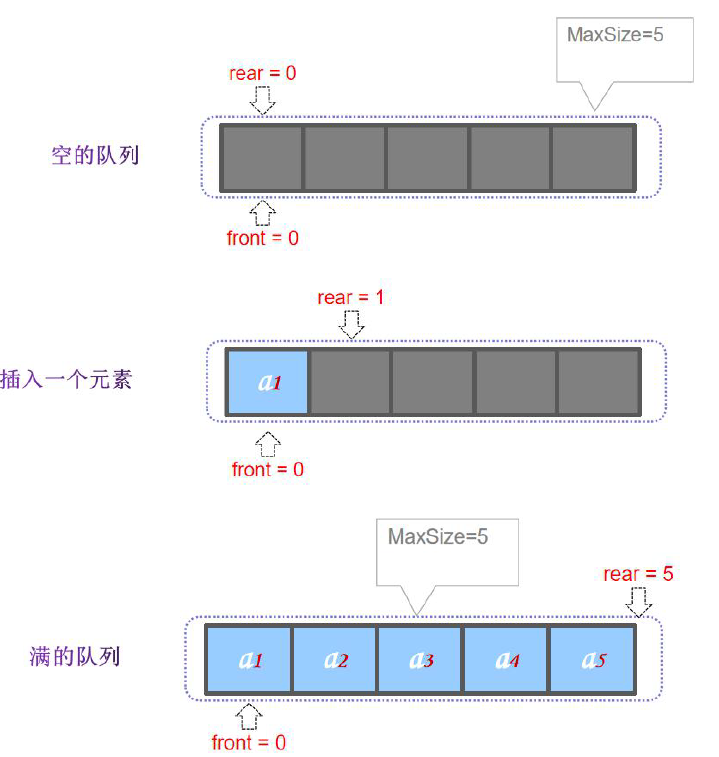
2.1队列定义
#define MaxSize 5 //队列的最大容量
typedef int DataType; //队列中元素类型
typedef struct Queue
{
DataType queue[MaxSize];
int front; //队头指针
int rear; //队尾指针
}SeqQueue;
2.2队列初始化
//队列初始化,将队列初始化为空队列
void InitQueue(SeqQueue *SQ)
{
if(!SQ) return;
SQ->front = SQ->rear = 0;//把对头和队尾指针同时置0
}
2.3队列为空
//判断队列为空
int IsEmpty(SeqQueue *SQ)
{
if(!SQ) return 0;
if (SQ->front == SQ->rear)
{
return 1;
}
return 0;
}
2.4队列为满
//判断队列是否为满
int IsFull(SeqQueue *SQ)
{
if(!SQ) return 0;
if (SQ->rear == MaxSize)
{
return 1;
}
return 0;
}
2.5入队
//入队,将元素data 插入到队列SQ 中
int EnterQueue( SeqQueue *SQ, DataType data)
{
if(!SQ) return 0;
if(IsFull(SQ))
{
cout<<"无法插入元素"<<data<<", 队列已满!"<<endl;
return 0;
}
SQ->queue[SQ->rear] = data; //在队尾插入元素data
SQ->rear++; //队尾指针后移一位
return 1;
}
2.6打印队列中的元素
//打印队列中的各元素
void PrintQueue(SeqQueue* SQ)
{
if(!SQ) return ;
int i = SQ->front;
while(i<SQ->rear)
{
cout<<setw(4)<<SQ->queue[i];
i++;
}
cout<<endl;
}
2.7出队
方式 1 - 删除 front 所指的元素, 后面所有元素前移 1 并返回被删除元素
//出队,将队列中队头的元素data 出队,后面的元素向前移动
int DeleteQueue(SeqQueue* SQ, DataType *data)
{
if(!SQ || IsEmpty(SQ))
{
cout<<"队列为空!"<<endl;
return 0;
}
if(!data) return 0;
*data = SQ->queue[SQ->front];
for(int i=SQ->front+1; i<SQ->rear; i++)//移动后面的元素
{
SQ->queue[i-1]=SQ->queue[i];
}
SQ->rear--;//队尾指针前移一位
return 1;
}
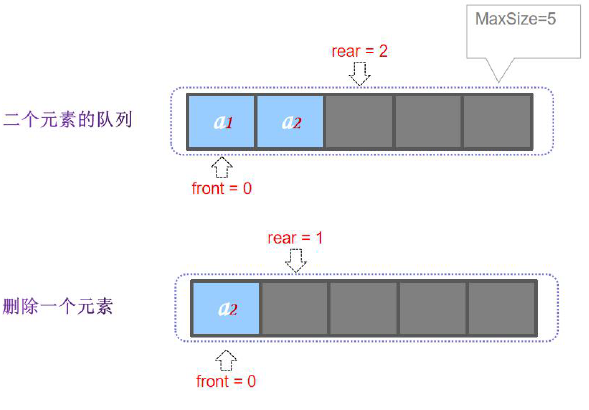
方式 2 - 删除 front 所指的元素,然后加 1 并返回被删元素。8979438401111
//出队,将队列中队头的元素data 出队,出队后队头指针front 后移一位
int DeleteQueue2(SeqQueue* SQ,DataType* data)
{
if (!SQ || IsEmpty(SQ))
{
cout<<"队列为空!"<<endl;
return 0;
}
if(SQ->front>=MaxSize)
{
cout<<"队列已到尽头!"<<endl;
return 0;
}
*data = SQ->queue[SQ->front]; //出队元素值
SQ->front = (SQ->front)+1; //队首指针后移一位
return 1;
}
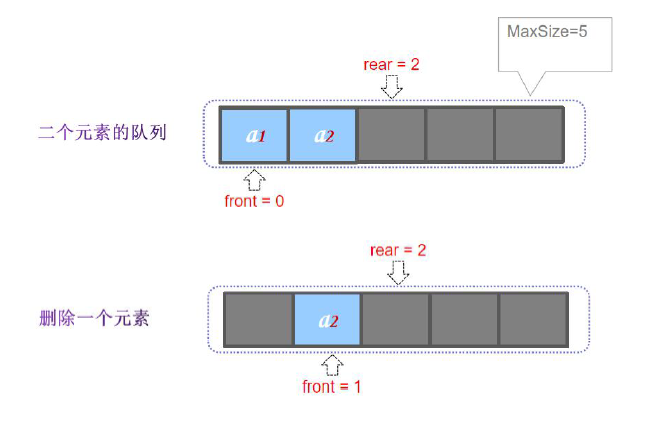
2.8取队首元素:返回front 指向的元素值
//获取队首元素
int GetHead(SeqQueue* SQ,DataType* data)
{
if (!SQ || IsEmpty(SQ))
{
cout<<"队列为空!"<<endl;
}
return *data = SQ->queue[SQ->front];
}
2.9清空队列
//清空队列
void ClearQueue(SeqQueue* SQ)
{
SQ->front = SQ->rear = 0;
}
2.10获取队列长度
//获取队列中元素的个数
int getLength(SeqQueue* SQ)
{
if(!SQ) return 0;
return SQ->rear-SQ->front;
}
完整代码
#include <stdio.h>
#include <assert.h>
#include <Windows.h>
#include <iostream>
#include <iomanip>
using namespace std;
#define MaxSize 5 //队列的最大容量
typedef int DataType; //队列中元素类型
typedef struct Queue
{
DataType queue[MaxSize];
int front; //队头指针
int rear; //队尾指针
}SeqQueue;
//队列初始化,将队列初始化为空队列
void InitQueue(SeqQueue* SQ)
{
if (!SQ) return;
SQ->front = SQ->rear = 0; //把对头和队尾指针同时置0
}
//判断队列为空
int IsEmpty(SeqQueue* SQ)
{
if (!SQ) return 0;
if (SQ->front == SQ->rear)
{
return 1;
}
return 0;
}
//判断队列是否为满
int IsFull(SeqQueue* SQ)
{
if (!SQ) return 0;
if (SQ->rear == MaxSize)
{
return 1;
}
return 0;
}
//入队,将元素data 插入到队列SQ 中
int EnterQueue(SeqQueue* SQ, DataType data)
{
if (!SQ) return 0;
if (IsFull(SQ))
{
cout << "无法插入元素" << data << ", 队列已满!" << endl;
return 0;
}
SQ->queue[SQ->rear] = data; //在队尾插入元素data
SQ->rear++; //队尾指针后移一位
return 1;
}
//出队,将队列中队头的元素data 出队,后面的元素向前移动
int DeleteQueue(SeqQueue * SQ, DataType * data)
{
if (!SQ || IsEmpty(SQ))
{
cout << "队列为空!" << endl;
return 0;
}
if (!data) return 0;
*data = SQ->queue[SQ->front];
for (int i = SQ->front + 1; i < SQ->rear; i++)//移动后面的元素
{
SQ->queue[i - 1] = SQ->queue[i];
}
SQ->rear--;//队尾指针前移一位
return 1;
}
//出队,将队列中队头的元素data 出队,出队后队头指针front 后移一位
int DeleteQueue2(SeqQueue* SQ, DataType* data)
{
if (!SQ || IsEmpty(SQ))
{
cout << "队列为空!" << endl;
return 0;
}
if (SQ->front >= MaxSize)
{
cout << "队列已到尽头!" << endl;
return 0;
}
*data = SQ->queue[SQ->front]; //出队元素值
SQ->front = (SQ->front) + 1; //队首指针后移一位
return 1;
}
//打印队列中的各元素
void PrintQueue(SeqQueue* SQ)
{
if (!SQ) return;
int i = SQ->front;
while (i < SQ->rear)
{
cout << setw(4) << SQ->queue[i];
i++;
}
cout << endl;
}
//获取队首元素,不出队
int GetHead(SeqQueue* SQ, DataType* data)
{
if (!SQ || IsEmpty(SQ))
{
cout << "队列为空!" << endl;
}
return *data = SQ->queue[SQ->front];
}
//清空队列
void ClearQueue(SeqQueue* SQ)
{
if (!SQ) return;
SQ->front = SQ->rear = 0;
}
//获取队列中元素的个数
int getLength(SeqQueue* SQ)
{
if (!SQ) return 0;
return SQ->rear - SQ->front;
}
int main()
{
SeqQueue* SQ = new SeqQueue;
DataType data = -1;
//初始化队列
InitQueue(SQ);
//入队
for (int i = 0; i < 7; i++)
{
EnterQueue(SQ, i);
}
//打印队列中的元素
printf("队列中的元素(总共%d 个):", getLength(SQ));
PrintQueue(SQ);
cout << endl;
//出队
for(int i=0; i<10; i++)
{
if (DeleteQueue2(SQ, &data))
{
cout << "出队的元素是:" << data << endl;
}
else
{
cout << "出队失败!" << endl;
}
}
//打印队列中的元素
printf("出队一个元素后,队列中剩下的元素:");
PrintQueue(SQ);
cout << endl;
system("pause");
return 0;
}
3.队列的链式存储
队列的链式存储结构,其实就是线性表的单链表,只不过它只是尾进头出而已,我们把它简称为链队列。为了
操作上的方便,我们将队头指针指向链队列的头结点,而队尾指针指向终端节点

3.1队列的定义
#define MaxSize 5 //队列的最大容量
typedef int DataType;//队列中元素的类型
typedef struct _QNode//结点结构
{
DataType data;
struct _QNode* next;
}QNode;
typedef QNode* QueuePtr;
typedef struct Queue
{
int length;//队列的长度
QueuePtr front;//队头指针
QueuePtr rear;//队尾指针
}LinkQueue;
3.2队列初始化
//队列初始化,将队列初始化为空队列
void InitQueue(LinkQueue* LQ)
{
if (!LQ) return;
LQ->length = 0;
LQ->front = LQ->rear = NULL;//把队头指针和队尾指针同时置0
}
3.3判断队列是否为空
//判断队列为空
int IsEmpty(LinkQueue *LQ)
{
if (!LQ) return 0;
if (LQ->front == NULL)
{
return 1;
}
return 0;
}
3.4判断队列是否为满
//判断队列是否为满
int IsFull(LinkQueue* LQ)
{
if (!LQ) return 0;
if (LQ->length == MaxSize)
{
return 1;
}
return 0;
}
3.5入队
空队列时,front 和rear 都指向空。
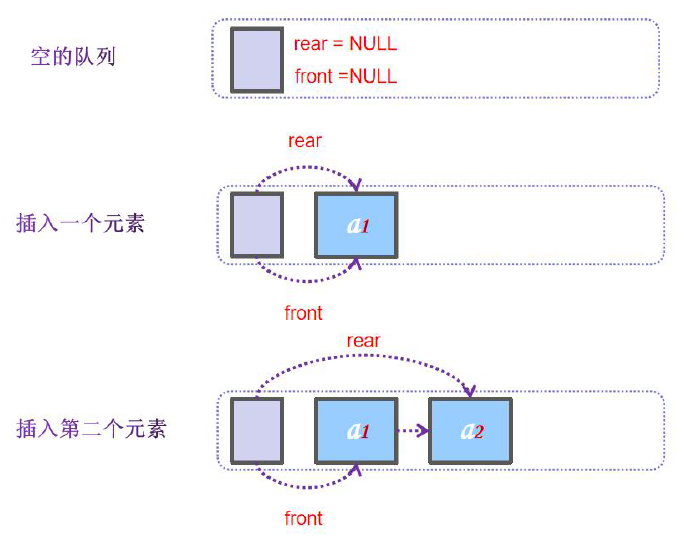
//入队,将元素data 插入到队列LQ 中
int EnterQueue(LinkQueue* LQ, DataType data)
{
if (!LQ) return 0;
if (IsFull(LQ))
{
cout << "队列无法插入元素" << data << ",队列已满" << endl;
return 0;
}
//创建结点
QNode* qNode = new QNode;
qNode->data = data;
qNode->next = NULL;
if (IsEmpty(LQ))//空队列
{
LQ->front = LQ->rear = qNode;
}
else
{
LQ->rear->next = qNode;//在队尾插入结点qNode
LQ->rear = qNode;//队尾指向新插入的结点
}
LQ->length++;
return 1;
}
3.6删除结点
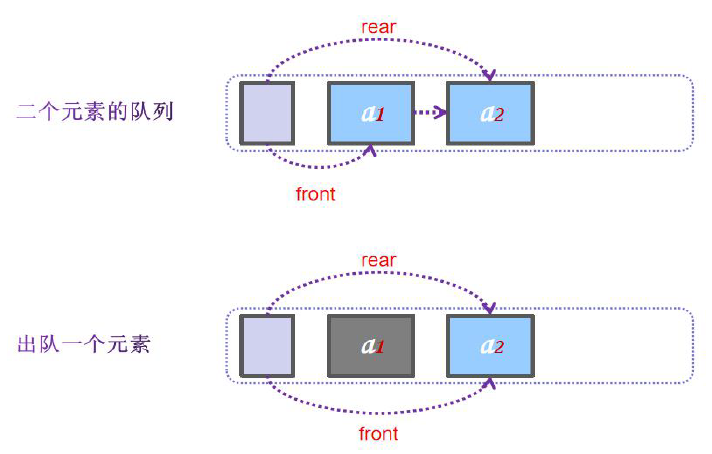
//出队,将队列中队头的元素data出队,后面的元素向前移动
int DeleteQueue(LinkQueue* LQ, DataType* data)
{
QNode* tmp = NULL;
if (!LQ || IsEmpty(LQ))
{
cout << "队列为空" << endl;
return 0;
}
if (!data)
return 0;
tmp = LQ->front;
LQ->front = tmp->next;
if (!LQ->front)
LQ->rear = NULL;//如果队头出列后不存在其他元素,则rear结点也要置空
*data = tmp->data;
LQ->length--;
delete tmp;//配合入队时用了new
return 1;
}
3.7获取队首元素
//获取队首元素,不出队
int GetHead(LinkQueue* LQ, DataType* data)
{
if (!LQ || IsEmpty(LQ))
{
cout << "队列为空!" << endl;
return 0;
}
if (!data) return 0;
*data = LQ->front->data;
return 1;
}
3.8清空队列
//清空队列
void ClearQueue(LinkQueue* LQ)
{
if (!LQ) return;
while (LQ->front)
{
QueuePtr tmp = LQ->front->next;
delete LQ->front;
LQ->front = tmp;
}
LQ->front = LQ->rear = NULL;
LQ->length = 0;
}
3.9获取队列中元素个数
//获取队列中元素的个数
int getLength(LinkQueue* LQ)
{
if (!LQ) return 0;
return LQ->length;
}
3.10打印队列中的元素
//打印队列中的各元素
void PrintQueue(LinkQueue *LQ)
{
QueuePtr tmp;
if(!LQ) return ;
if(LQ->front==NULL)
{
cout<<"队列为空!";
return ;
}
tmp = LQ->front;
while(tmp)
{
cout<<setw(4)<<tmp->data;
tmp = tmp->next;
}
cout<<endl;
}
完整代码
#include <stdio.h>
#include <assert.h>
#include <Windows.h>
#include <iostream>
#include <iomanip>
using namespace std;
#define MaxSize 5 //队列的最大容量
typedef int DataType; //队列中元素类型
typedef struct _QNode//结点结构
{
DataType data;
struct _QNode* next;
}QNode;
typedef QNode* QueuePtr;
typedef struct Queue
{
int length; //队列的长度
QueuePtr front; //队头指针
QueuePtr rear; //队尾指针
}LinkQueue;
//队列初始化,将队列初始化为空队列
void InitQueue(LinkQueue* LQ)
{
if (!LQ) return;
LQ->length = 0;
LQ->front = LQ->rear = NULL; //把对头和队尾指针同时置0
}
//判断队列为空
int IsEmpty(LinkQueue* LQ)
{
if (!LQ) return 0;
if (LQ->front == NULL)
{
return 1;
}
return 0;
}
//判断队列是否为满
int IsFull(LinkQueue* LQ)
{
if (!LQ) return 0;
if (LQ->length == MaxSize)
{
return 1;
}
return 0;
}
//入队,将元素data 插入到队列LQ 中
int EnterQueue(LinkQueue* LQ, DataType data)
{
if (!LQ) return 0;
if (IsFull(LQ))
{
cout << "无法插入元素" << data << ", 队列已满!" << endl;
return 0;
}
QNode* qNode = new QNode;
qNode->data = data;
qNode->next = NULL;
if (IsEmpty(LQ))//空队列
{
LQ->front = LQ->rear = qNode;
}
else
{
LQ->rear->next = qNode;//在队尾插入节点qNode
LQ->rear = qNode; //队尾指向新插入的节点
}
LQ->length++;
return 1;
}
//出队,将队列中队头的元素出队,其后的第一个元素成为新的队首
int DeleteQueue(LinkQueue* LQ, DataType* data) {
QNode* tmp = NULL;
if (!LQ || IsEmpty(LQ))
{
cout << "队列为空!" << endl;
return 0;
}
if (!data) return 0;
tmp = LQ->front;
LQ->front = tmp->next;
if (!LQ->front) LQ->rear = NULL;//如果对头出列后不存在其他元素,则rear节点也要置空
* data = tmp->data;
LQ->length--;
delete tmp;
return 1;
}
//打印队列中的各元素
void PrintQueue(LinkQueue* LQ)
{
QueuePtr tmp;
if (!LQ) return;
if (LQ->front == NULL)
{
cout << "队列为空!";
return;
}
tmp = LQ->front;
while (tmp)
{
cout << setw(4) << tmp->data;
tmp = tmp->next;
}
cout << endl;
}
//获取队首元素,不出队
int GetHead(LinkQueue* LQ, DataType* data)
{
if (!LQ || IsEmpty(LQ))
{
cout << "队列为空!" << endl;
return 0;
}
if (!data) return 0;
*data = LQ->front->data;
return 1;
}
//清空队列
void ClearQueue(LinkQueue* LQ)
{
if (!LQ) return;
while (LQ->front)
{
QueuePtr tmp = LQ->front->next;
delete LQ->front;
LQ->front = tmp;
}
LQ->front = LQ->rear = NULL;
LQ->length = 0;
}
//获取队列中元素的个数
int getLength(LinkQueue* LQ)
{
if (!LQ) return 0;
return LQ->length;
}
int main()
{
LinkQueue* LQ = new LinkQueue;
DataType data = -1;
//初始化队列
InitQueue(LQ);
//入队
for (int i = 0; i < 7; i++) {
EnterQueue(LQ, i);
}
//打印队列中的元素
printf("队列中的元素(总共%d 个):", getLength(LQ));
PrintQueue(LQ);
cout << endl;
//出队
for(int i=0; i<10; i++)
{
if (DeleteQueue(LQ, &data))
{
cout << "出队的元素是:" << data << endl;
}
else
{
cout << "出队失败!" << endl;
}
}
//打印队列中的元素
printf("出队一个元素后,队列中剩下的元素[%d]:", getLength(LQ));
PrintQueue(LQ);
cout << endl;
ClearQueue(LQ);
cout << "清空队列!\n";
PrintQueue(LQ);
//清理资源
delete LQ;
system("pause");
return 0;
}
参考资料来源:
奇牛学院


